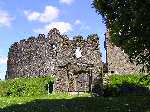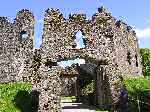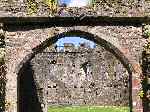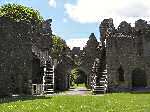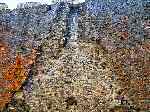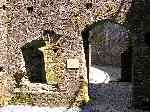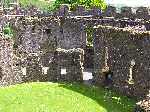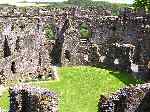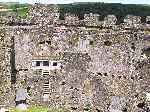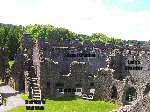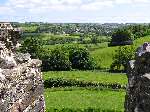Restormel castle, lies near the town of Lostwithiel, in
a strategic position guarding a river crossing of the river Fowey. The
earliest castle on the site was built after the Norman invasion about
1100AD. Little remains of this original castle with much of the present
remains being built in the 13th century by Richard, Earl of Cornwall who
was the younger brother of Henry III. Richard died in 1299 without heirs
and his estates, including the castle, reverted to the Crown. In 1337
the "Black Prince", eldest son of Edward III, was given the title of Duke
of Cornwall, this title has been inherited by the eldest son of the monarch
to this day. The "Black Prince" visted his castle at Restormel twice,
in 1354 and later, at Christmas 1365. After this period the castle fell
into disrepair with little maintenance being done except for a brief spell
during the Civil War when the Parliamentary army under Lord Essex garrisoned
the castle before being evicted by a Royalist force under Sir Richard
Grenville in 1644. It becam an ivy covered ruin hidden in a wood before
its guardianship was passed to the then Ministry of Works in 1925. They
cleared the site and conserved what remained, work which is still done
today by English Heritage.
The early castle would have been built for defence in the early years
of the Norman invasion when they were still exercising their grip on the
country. It was a well chosen site sitting on a natural high point thus
alleviating the need for a motte or artificial mound. It consisted of
a circular earthwork with a rectangular bailey; little is know about the
rest of the buildings although there is much specualtion about three pits
dug inside the bedrock, a fourth pit contained the castle's well. The
other pits could well have been the site of towers. The re-building of
the castle in the 13th and 14th century made the castle more of a status
symbol and a hunting lodge (originally the castle was surrounded by a
deer park) than a serious defensive site. This can be seen by the presence
of windows rather than arrow slits and especially the large windows in
the principal rooms. The castle that remains today is what is known as
a shell keep with little of the outer bailey remaining. However the wall
walk survives and it is this that gives the castle much of its 'hands-on'
feel. Climbing the staircase you can walk right around the parapet where
you can see not only the fine views across the valley but also the principal
apartments contained within the shell keep. The circular arrangement of
Kitchen, Servery, Great Hall, Lord's chamber, Chapel, Lady's chamber and
Guardrooms around the inner courtyard; makes the castle, as seen from
the wall walk, look like an amphitheatre. |
